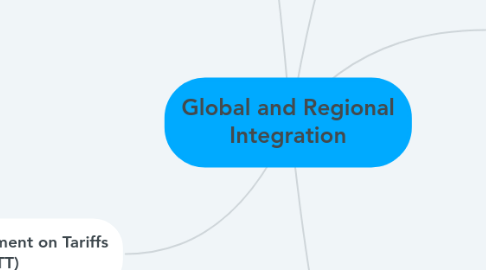
1. General Agreement on Tariffs and Trade (GATT)
1.1. The main purpose of the GATT was substantial reduction of tariffs and other trade barriers and the elimination of preferences, on a reciprocal and mutually advantageous basis.
1.1.1. General Agreement on Trade in Services (GATS)
1.1.1.1. GATS was stimulated by the same objectives as GATT in merchandise trade:
1.1.1.2. creating a credible and reliable system of international trade rules
1.1.1.3. ensuring fair and equitable treatment of all participants (nondiscrimination)
2. World Trade Organization (WTO)
2.1. is the only international organization dealing with the global rules of trade. Its main function is to ensure that trade flows as smoothly, predictably and freely as possible.
2.1.1. GATT mechanisms experienced long delays, blocking by accused countries, and inadequate enforcement
2.1.2. WTO addresses all three problems:
2.1.3. sets time limits for a panel, consisting of three neutral countries, to reach a judgment
2.1.4. removes the power of accused countries to block unfavorable decisions
2.1.5. WTO recommends that losing countries change their laws or practices and authorizes winning countries to use tariff retaliation to compel offending countries’ compliance with WTO rulings
2.2. Does the WTO Really Matter?
2.2.1. The WTO helps trade throughout the world flow smoothly through its trade agreements. Members of the WTO know what the rules are. They understand the penalties for breaking the rules
3. Global Economic Integration
3.1. the process where two or more countries are eliminating among them the different economic barriers they may have
4. Regional Economic Integration
4.1. free trade area (FTA) - group of countries that remove trade barriers among themselves while each still maintains different external policies regarding nonmembers customs union - imposes common external policies on nonparticipants to combat trade diversion common market - permits the free movement of goods and people economic union - members coordinate and harmonize economic policies (in areas such as monetary, fiscal, and taxation) to blend their economies into a single economic entity
4.2. TRADES
4.2.1. North American Free Trade Agreement (NAFTA)
4.2.2. Andean Community and Mercosur
4.2.3. Central America Free Trade Agreement (CAFTA) 1995
4.2.4. Free Trade Area of the Americas (FTAA)
